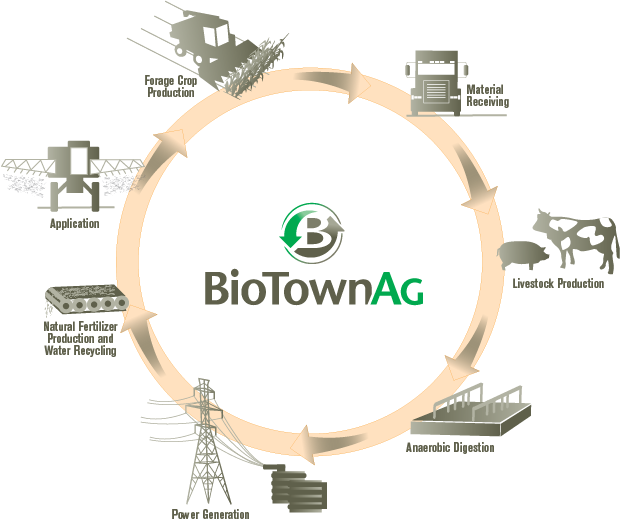BioTown Ag: Moving Sustainability Forward.

Who is Involved?
When we talk about a community, we mean something that is bigger than just farming. It is the cycle of how what you grow makes its way to the table of consumers. In the case of community and Bio Town Ag, the members include farmers and corporations, cities and municipalities, and consumers like you.
Why Bio Town Ag is Different?
There are a few other bio recyclers nationally. Those facilities do not accept waste from outside systems. Bio Town Ag is the only waste recycler that takes organic bio-waste from corporations and turns it into renewable energy. In so doing, municipalities benefit because the waste, which Bio Town Ag takes in, does not find its way to landfills or sewer treatment plants. Instead, it becomes a contributing factor for renewable energy that powers farms and households throughout the community. Bio Town Ag creates 5 Megawatts of green energy each year.
Gains to Local Farmers
What Bio Town Ag is building are the links that turn waste into usable, green, sustainable products that help farmers lower costs, produce better products, and improve their land. In the current system, resources must keep being added to the beginning of the process for the system to work. Those products are green energy and organic fertilizer. The fertilizer is used by farmers to grow better feed crops. Better quality organic fertilizer means healthier plants that produce better feed. Better feed means that cattle and swine producers grow better stock in potentially less time. Faster time to market means higher ROI for both farmers and ranchers. A healthier end product is also a plus for consumers. What farms gain is all of the ingredients to make a better product. Organic fertilizers help replenish soil health and soil nutrients without using chemicals. We are what we eat, and the same is true for plants. Better soil health and better nutrients lead to better quality crops; which leads to better feed for cattle and swine. How can Bio Town Ag help improve your product cycle?
How does it work?
By collecting bio-waste from stock (manure) and organic waste from corporations, Bio Town Ag can produce 5 megawatts electricity that comes from methane. The key to the project is the Bio Town Ag digester that utilizes natural processes to produce methane with a result of rich organic fertilizer. The current system requires new resources for field regeneration so there is little recovery of end waste products from farms or municipalities, thus the ROI of the current system is limited. It costs farmers more to by non-organic fertilizers, and livestock producers pay more for higher quality feeds. Municipalities and corporations pay more to process waste from corporate production, and the costs passes to consumers like you and me. Bio Town Ag closes this system and recovers the waste, which is then recycled into green energy and better fertilizer. This new process boosts ROI on all fronts, making it a win-win for all those involved, including consumers. How can Bio Town Ag boost your company’s ROI?
